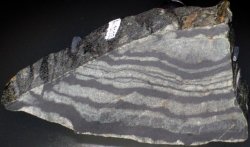
August Editorial

August Editorial
How Old is Life on Earth? |
|
This question is often debated. It is important because life has a significant effect on the chemical processes of a planet – for example in soaking up CO2 from the atmosphere and sequestering it in the earth. (This is what trees do with coal. ) Also, if we can determine how early in the history of planet earth life first originated, then, because we know what conditions existed at that time, it will help to determine whether life might also exist on other planets. |
|
|
Of course, as we are looking across a time frame of billions of years, there is only one place where the evidence might remain, and that is within the most ancient rocks on planet Earth. Even these rocks are rare, for they date to just after the Hadean era of about 4.5 billion years ago, when the first seas began to form on the Earth's crust. As the crust was still cooling, these seas were warm – around 50oC and agitated by the violent tectonic activity which the planet was still experiencing. There was little to no free oxygen, because oxygen is highly reactive and needs life to produce it as a waste product before there are significant amounts in the atmosphere. Therefore the first life forms were sulphur-consuming bacteria. These bacteria excreted pyrite, so tiny crystals of pyrite which occur in sedimentary sandstone are suggestive evidence of life which once existed in the first seas. When these crystals appear together with regular patterns which appear to be the fossilized remains of microscopic cells, this is a clear indication of early life. Until recently the earliest accepted evidence for microfossils was to be found in layered black sandstone at Shirley Pool in Western Australia - the world's oldest preserved shoreline. This former shallow water beach yielded evidence of biological activity 3.4 billion years ago - but now the date for the start of life on earth has been pushed back yet again, to 3.7 billion years. That is the claim published in the journal Nature at the end of August this year (2016) in a paper with lead author Allen Nutman, of the University of Wollongong in Australia. Dr Nutman and his team went looking for life on the opposite side of the planet, in the even older Isua supercrustal belt of metamorphosed sedimentary rocks in south-west Greenland. The rocks here have recently been exposed by changing climatic factors, and in one 3,700 million year-old outcrop the scientists found evidence for tiny 1cm high stromatolites - layered clusters of millions of bacterial cells which represent a form of primitive life so successful that specimens still survive today. Stromatolites grow in shallow marine environments, such as that which existed at the Isua supercrustal belt, as evidenced by the signature of the seawater rare-earth element yttrium in the metacarbonates, and detrital interlayering in the sedimentary rocks with cross-layering indicative of storm wave activity. However, the finding is still controversial, because the rock in which the evidence for the stromatolites were discovered was metamorphosed sandstone, and usually the intense stress and heat (around 550oC) bakes out any possible evidence of early life. Nevertheless, others argue, if the biological material had already dried out then it might survive the baking. If proven, this discovery could have significance beyond the Earth as early in that planet's history Mars had similar conditions to the immediate post-Hadean era. As the Greenland evidence suggests that life takes root almost as soon as liquid water exists on a planet's surface, there is a possibility that the same thing happened on Mars. At least scientists now know what to look for, and where. Journal Reference: Image above: Graphitic banded iron-formation (meta-BIF) from the Precambrian of Greenland (FMNH Li 9223, Field Museum of Natural History, Chicago, Illinois, USA). James St. John shared under Creative Commons license. (https://creativecommons.org/licenses/by/2.0/legalcode) | |
| _______________________________ | ||||
| Home | | | Shopping | | | Database |
© Biscuit Software 2004-2015
All rights reserved